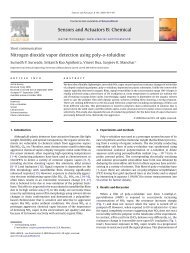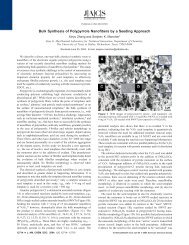Nanofibers of polyaniline synthesized by ... - Sanjeev Manohar
Nanofibers of polyaniline synthesized by ... - Sanjeev Manohar
Nanofibers of polyaniline synthesized by ... - Sanjeev Manohar
Create successful ePaper yourself
Turn your PDF publications into a flip-book with our unique Google optimized e-Paper software.
24 X. Zhang et al. / Synthetic Metals 145 (2004) 23–29<br />
<strong>polyaniline</strong> nan<strong>of</strong>ibers using different dopants and/or surfactants<br />
in the aqueous phase. Also described is their aqueous<br />
electrochemistry including capacitive charge/discharge<br />
measurements which demonstrate their potential in energy<br />
storage applications.<br />
2. Experimental<br />
2.1. Materials<br />
Aniline (99.5+%), ammonium peroxydisulfate (98%),<br />
2-acrylamido-2-methyl-1-propanesulfonic acid (AMPSA),<br />
10-camphorsulfonic acid (98%), dodecylbenzenesulfonic<br />
acid (DBSA), octylphenol ethoxylate Triton-X 100, sodium<br />
di(2-ethylhexyl) sulfosuccinate aerosol-OT (AOT), 1-<br />
methyl-2-pyrrolidinone, NMP (99%), toluene and acetonitrile<br />
were purchased from Sigma-Aldrich (Milwaukee,<br />
WI). The single-tailed non-ionic surfactant d-Alpha<br />
Tocopheryl Polyethylene Glycol 1000 Succinate (Vitamin<br />
E TPGS) was purchased from Eastman Chemical<br />
Company. The twin-tailed surfactants, potassium cis-1,2-<br />
dipentylethene sulfonate (C 5 H 11 -twin-tailed) and potassium<br />
cis-1,2-diheptylethene sulfonate (C 7 H 13 -twin-tailed) were<br />
<strong>synthesized</strong> in-house (see Table 1 for structure) [18].<br />
2.2. Instrumentation and measurements<br />
Cyclic voltammetry was carried out (Arbin Instruments,<br />
model MSTAT4+) in aq. 1.0 M CSA or HCl electrolyte <strong>by</strong><br />
cycling the potential between −0.2 and 0.9 V (SCE reference)<br />
at 20 mV/s using Pt mesh as the working electrode and<br />
Pt wire as the counter electrode. Standard pre-equilibration<br />
procedures were followed [19]. Open-circuit potential (V oc )<br />
measurements were made using Pt foil as the working electrode<br />
versus SCE reference.<br />
Capacitance measurements were performed <strong>by</strong> first identifying<br />
the potential range 0.4–0.5 V as a representative<br />
non-Faradaic region in the cyclic voltammogram <strong>of</strong> <strong>polyaniline</strong><br />
and the area under the current–voltage plot representing<br />
the charge (or discharge) capacity was continuously<br />
recorded. The working electrode was Pt mesh which was<br />
folded at the tip. Within the fold an accurately weighed<br />
amount <strong>of</strong> <strong>polyaniline</strong> nan<strong>of</strong>ibers (∼2 mg) was pressed<br />
using a spatula. In all other fashions the experiment was<br />
similar to cyclic voltammetry described above. Using the<br />
features available in the MSTAT4+ potentiostat, the charge<br />
and discharge cycles were simultaneously monitored and<br />
cumulatively added over a total <strong>of</strong> 50 cycles and plotted.<br />
This plot provides more information than the conventional<br />
“rectangular box” plots normally employed in capacitance<br />
measurements. The capacitance (F/g) was calculated using<br />
the formula: capacitance (F/g) = charge (Q)/voltage (V) =<br />
(Ah × 3600)/(# cycles × voltage range × wt.) = (mAh ×<br />
3.6)/(50 × 0.1V× weight (g)).<br />
Elemental analyses were performed <strong>by</strong> Atlantic Microlab,<br />
Inc. Prior to analysis, samples were heated to ∼80 ◦ C<br />
in a vacuum oven for 72 h. Scanning electron microscopy<br />
(SEM) images were obtained using a Leo 1530 VP Field<br />
Emission Scanning Electron Microscope. The average fiber<br />
diameter was estimated directly from the instrument s<strong>of</strong>tware<br />
and confirmed <strong>by</strong> importing the image and the scale<br />
bar into an image editing s<strong>of</strong>tware (MS Paint). Four lines<br />
were drawn from edge to edge across the image, diagonals<br />
(2), vertical (1) and horizontal (1). In all instances where<br />
the line intersected the fiber image, the edge-to-edge pixel<br />
counts were measured. An average <strong>of</strong> all such crossings provided<br />
an estimate <strong>of</strong> the average fiber diameter.<br />
Table 1<br />
Average fiber diameter and capacitance <strong>of</strong> <strong>polyaniline</strong> nan<strong>of</strong>ibers<br />
Dopant Surfactant Fiber diameter (nm) Capacitance (F/g)<br />
CSA None ∼48 65<br />
CSA Triton-X 100 (non-ionic) ∼80 NA<br />
CSA Vitamin E TPGS (non-ionic) ∼60 NA<br />
CSA DBSA (anionic) ∼50 NA<br />
CSA AOT twin-tailed (anionic) ∼30 NA<br />
CSA C 5 H 11 -twin-tailed (anionic) ∼35 111<br />
CSA C 7 H 13 -twin-tailed (anionic) ∼28 154<br />
AMPSA None ∼23 277<br />
AMPSA C 5 H 11 -twin-tailed (anionic) ∼39 55<br />
AMPSA C 7 H 13 -twin-tailed (anionic) ∼53 96<br />
AMPSA None Non-fibrillar a 11<br />
a Obtained <strong>by</strong> destroying the fibrillar morphology <strong>of</strong> <strong>polyaniline</strong>·AMPSA nan<strong>of</strong>ibers using the procedure outlined in Section 2.




